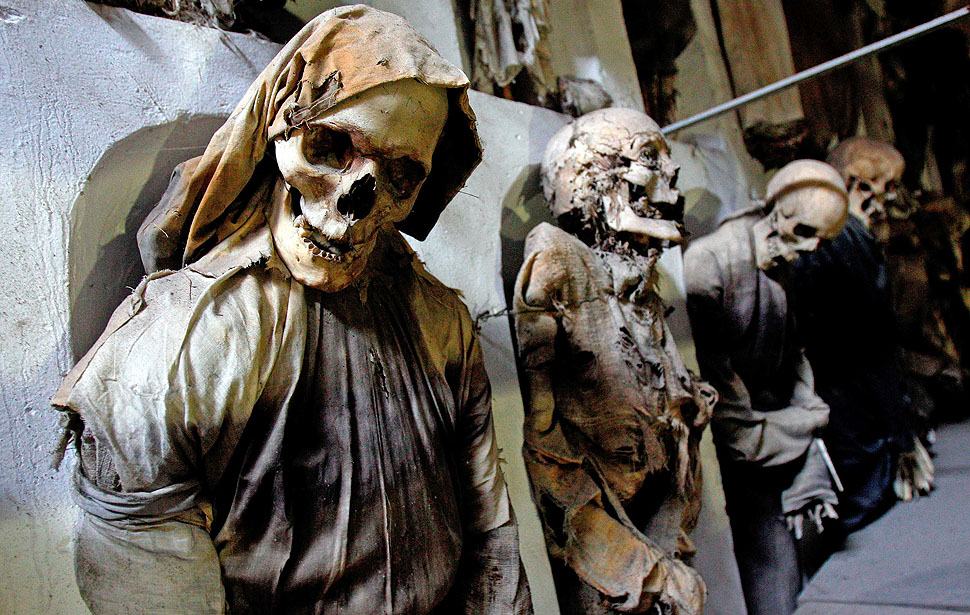
Halloween is fast approaching, so what better way to welcome the holiday than to take a tour through the creepiest, eeriest, and downright scariest spots in all of Italy! Consider a trip to one or all of these sinister haunts on the other side of bell’Italia, or no if you’re easily spooked!
1. Chapel of the Dead (Cappela Mortiti) in Otranto
If you take a trip to this incredible cathedral built by the Normans in the 11th century in Otranto, a town in the southernly province of Apulia, you’ll see the display of the bones and skulls of 813 Otranto martyrs beheaded during the infamous Turkish massacre in 1480 in the Cappella Mortiri (Chapel of the Dead). Exhibited as well in glass cases behind the altar is the stone upon which these gruesome acts were allegedly performed. On top of that, there’s also the sinister crypt reminiscent of a dungeon that visitors can brave.
2. Ca’Dario in Venice
Many consider Venice to be one of the most haunted cities in Europe, and Ca’Dario is a prime example. Architecturally beautiful Ca’Dario is a home on the edge of the Canal Grande; locals refer to it as the ‘house of no return’ because of the eerie deaths that have occurred to anyone who has owned the building. Built in the 15th century, the original owner and designer Giovanni Dario lost his son to murder and daughter to suicide while they lived in the house. There were two more murders and suicides in Ca’Dario and the 13 successive owners have all died mysteriously.
3. Capuchin Catacombs in Palermo
Italy has no shortage of creepy catacombs. The Capuchin Catacombs is a burial crypt off the mainland in Palermo, Sicily, and was originally meant to serve just the monks of the Capuchin monastery. Eventually others were allowed to be buried there, and it turned into a status symbol for those allowed in. 8,000 mummies line the walls and the bodies are in varying states of decomposition with some morbidly set up in poses. The catacombs are open to tourists and many have claimed to hear whistling, whispering, and even returned to a room to find skeletons moved into different positions.
4. The Mummies of Ferentillo in Umbria
The tiny town of Ferentillo in southern Umbria has an ominous surprise below the Church of Santo Stefano. Bodies buried there were preserved by a rare microfungus that attacked the corpses and turned them into mummies, some of which are on display in a The Museum of the Mummies of Ferentillo in the bottom of the church. Some of the corpse still have hair, beards and teeth, and a few are wearing clothes. Among the corpses on display are a mother with her baby and a lawyer who was murdered and his murderer.
5. The Museum of Purgatory in Rome
In the small church of Sacra Cuore Suffragio near Castle Sant’Angelo in the center of Rome is the one-room Museum of Souls in Purgatory. It purports to have recorded various "instances" of souls trapped between heaven and hell trying to draw the attention of the living to ask them for their prayers and help them pass into heaven. You can see ‘evidence’ of purgatory (and the paranormal), such as photos of imprints on sleeves and handprints burned onto the pages of prayer books.
6. Witches Village of Triora in Liguria
In 1587, in the village of Triora located in Italy’s Liguria region, there was a famine that lasted over two years. A group of women who met at night in a place called the “Cabotina” were blamed for it and were accused of witchcraft (causing storms that ruined crops, infanticide, sex with the devil, making poisonous potions, transforming themselves into cats so they could sneak into houses, etc.). Witch trials were held, and 300 women were accused and interrogated. Fifty of them were tortured, during which some died. The Triora museum is dedicated to the women who were tortured and killed and records of their confessions are on exhibit.
7. Medieval Criminal and Torture Museum in Tuscany
In San Gimignano, a small medieval town in Tuscany, there is a Medieval Criminal and Torture Museum, where you can see disturbing devices used to torture victims during the Roman Inquisition. These include instruments such as Iron Maidens, Guillotines and torture chairs used on those considered Heretics. Some of the common charges included practicing homosexuality, promiscuity, Judaism and Protestantism.
8. Poveglia in Venice
Definitely one of, if not the creepiest place in Italy (and maybe even Europe), is the island of Poveglia. Closed to tourists, and therefore known as ‘The Forbidden Island,’ it’s located in the Venetian lagoon. The famous legend has it that a healer (or witch as many believed) cursed the island, proclaiming it to never be inhabited again; and people refused to live there. Eventually, it was used as a mass burial ground during the Black Death and other plagues. When ships entering the Lagoon were found to carry the plague, passengers were quarantined on Poveglia.
Later, it was turned into a hospital for the mentally ill. As the story goes, a doctor there tortured and butchered patients with experimental therapies. He went mad himself and jumped from a window to his death, but his body was never found. Through its recorded history, it is believed that at least 160,000 people died on Poveglia, confirming its status as one of the places in the world with the highest amount of deaths per square meter. Allegedly, the island is haunted by the people who died there, and some who pass by report hearing cries and screams.
Photo credit: Entmood
